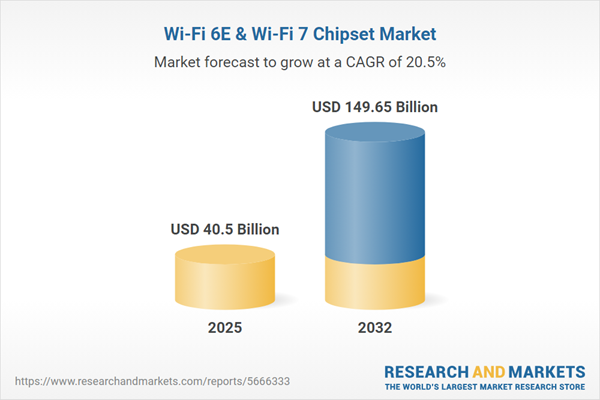Speak directly to the analyst to clarify any post sales queries you may have.
Next-generation wireless advancements are reshaping enterprise infrastructure as organizations seek resilient, high-performance connectivity. The Wi-Fi 6E and Wi-Fi 7 chipset market offers decision-makers the tools to ensure operational continuity and meet complex digital transformation requirements.
Market Snapshot: Wi-Fi 6E and Wi-Fi 7 Chipset Market Overview
The Wi-Fi 6E and Wi-Fi 7 chipset market is expanding rapidly, with projections indicating a rise from USD 33.65 billion in 2024 to USD 40.50 billion by 2025, and estimates reaching USD 149.65 billion by 2032. This growth reflects a notable CAGR of 20.50%, primarily driven by organizations upgrading their wireless networks in response to rising digital application use and increasing data volume. Modern enterprises require scalable, secure wireless infrastructure capable of supporting diverse and demanding workloads. Industries making substantial technology investments are transitioning to advanced chipsets to improve network performance, facilitate secure operations, and support robust digital transformation strategies.
Scope & Segmentation: Strategic Investment Areas in the Wi-Fi 6E and Wi-Fi 7 Chipset Market
This report delivers actionable intelligence for leaders assessing wireless chipset adoption, clarifying priority segments to strengthen enterprise connectivity. Decision-makers gain clarity on how segmentation addresses specific deployment, operational, and industry objectives across regions and technologies.
- Application Areas: Automotive organizations implement advanced chipsets to support secure, reliable vehicle connectivity and enhance driver-assistance systems. In consumer electronics, manufacturers drive higher interactivity and seamless device experiences with updated wireless integration. Enterprises emphasize improved workforce mobility, while healthcare adopts secure, high-speed wireless for telemedicine and remote diagnostics. Industry operators deploy chipsets to enable robotics, automation, and smart manufacturing environments.
- End Users: Commercial enterprises in sectors such as hospitality, offices, and retail seek enhanced connectivity to increase operational efficiency and elevate customer engagement. Industrial segments—including utilities and manufacturing—prioritize automation and resilient communications infrastructure. Residential users focus on smart technology integration and flexible, connected home environments.
- Chipset Technologies: Integrated combo chips provide straightforward deployment for rapid delivery and compatibility, while discrete chipsets offer a tailored approach in high-volume or specialized scenarios. System-on-chip solutions bring high-density integration, maximizing energy efficiency and aligning with sustainability targets.
- Distribution Channels: Organizations maintain robust supply chains utilizing established resellers and digital platforms, ensuring prompt response to evolving logistical demands and market conditions.
- Regional Coverage: The Americas, Europe, Middle East and Africa, and Asia-Pacific each offer unique opportunities and regulatory landscapes, guiding deployment strategies and technology adoption in response to local dynamics.
- Company Profiles: The industry includes innovation-focused leaders such as Broadcom, Qualcomm, MediaTek, Marvell, Intel, Realtek, NXP Semiconductors, Texas Instruments, Samsung Electronics, and Silicon Laboratories. These companies exhibit diverse approaches to integration and product differentiation across the competitive landscape.
Key Takeaways: Strategic Insights for Decision-Makers
- The expanded wireless spectrum empowers businesses to scale connectivity, supporting data-rich operational environments where performance stability and capacity are critical.
- Next-generation chipset architectures enhance automation and real-time data management, particularly in healthcare and manufacturing, strengthening capabilities for time-sensitive applications.
- Collaborations between chipset vendors and device manufacturers improve compatibility, enabling tailored wireless infrastructure to address bespoke enterprise requirements.
- Maintaining a flexible supply approach—leveraging diverse distribution channels—supports organizational agility in facing evolving international trade and supply scenarios.
- Ongoing improvements in wireless security and system reliability support compliance and data protection needs for sectors operating under stringent regulatory requirements.
Tariff Impact: Navigating Evolving Trade Dynamics
Recent changes to United States tariff policy are prompting chipset suppliers to diversify sources and manufacturing, leading to more adaptive global supply chains. Businesses are proactively adopting flexible procurement and inventory frameworks, which reduces exposure to market and trade uncertainties. This strategic adaptability underpins business continuity and helps maintain stability during changing trade regulations.
Methodology & Data Sources
This report’s key findings are built on direct interviews with wireless technology experts, as well as a thorough review of relevant technical and market literature. Each data point undergoes rigorous validation, giving senior leaders a reliable foundation for strategic decisions.
Why This Report Matters
- Empowers executives with the insights needed to select wireless technology that fuels organizational transformation and sustainable growth.
- Enables suppliers and buyers to navigate regulatory complexities and adapt business models with detailed regional and compliance perspectives.
- Supports effective investment and operational planning as wireless connectivity evolves in speed, scale, and strategic relevance.
Conclusion
Adopting Wi-Fi 6E and Wi-Fi 7 chipsets positions organizations to deliver secure, agile connectivity. This investment supports long-term competitiveness and operational flexibility as digital infrastructure requirements evolve.
Additional Product Information:
- Purchase of this report includes 1 year online access with quarterly updates.
- This report can be updated on request. Please contact our Customer Experience team using the Ask a Question widget on our website.
Table of Contents
3. Executive Summary
4. Market Overview
7. Cumulative Impact of Artificial Intelligence 2025
Companies Mentioned
The companies profiled in this Wi-Fi 6E & Wi-Fi 7 Chipset market report include:- Broadcom Inc.
- Qualcomm Incorporated
- MediaTek Inc.
- Marvell Technology Group Ltd.
- Intel Corporation
- Realtek Semiconductor Corporation
- NXP Semiconductors N.V.
- Texas Instruments Incorporated
- Samsung Electronics Co., Ltd.
- Silicon Laboratories Inc.
Table Information
| Report Attribute | Details |
|---|---|
| No. of Pages | 189 |
| Published | November 2025 |
| Forecast Period | 2025 - 2032 |
| Estimated Market Value ( USD | $ 40.5 Billion |
| Forecasted Market Value ( USD | $ 149.65 Billion |
| Compound Annual Growth Rate | 20.5% |
| Regions Covered | Global |
| No. of Companies Mentioned | 11 |









